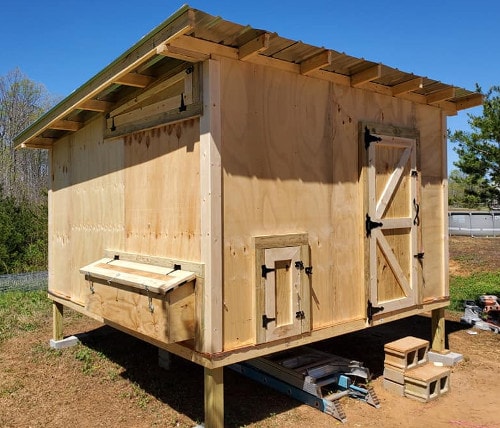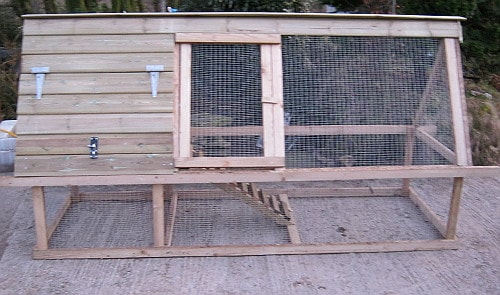Should Chicken coops be raised up of the ground?

I need to start this page by saying that here is no type of chicken coop or poultry building best suited to all locations and situations.
Every place is different and every keepers has slightly different requirements so your final choice is likely to be a compromise between What you want, What you need and how much you have to spend.
Why are many coops raised off the ground?
There are a good few reasons for raising a coop:
- Having a raised coop allows me to grab the eggs without stooping and bending.
- Snakes are less likely to get into the coop if it is raised off the ground.
- Snow. A higher coop will be easier to access in deep snow with less shovelling to get the doors open.
- Vermin are less likely to hide or burrow under a raised coop.
- A raised coop allows air to circulate freely underneath, cooling the coop during hot weather.
- A raised coop floor will not rot as fast as one on earth.
- A raised coop is easier to clean.
- It instantly adds extra space under the coop for your chickens to hide in bad weather, dust bathe, or just rest in the shade.
- You can level the coop on uneven ground.
It was a revelation for me when I raised my first coop just high enough to get a wheel barrow under the edge, it was an end to shovelling. I just used the back of a rake and coop cleaning time was quartered. The coop is much easier to clean when it's above ground and, very important for some areas, they won't flood or get wet from heavy rains, run-off, etc.
Mine are nearly three feet off the ground. It also allows me to hang the feeder from the edge and it is just the right height for the chickens.
Some other pro's would be shade for the chickens, dryer when it rains, and add a bunch of sand under and dust baths in the shade
What about large walk-in coops?
Housing chickens may well be the hardest thing to decide on, with space available, number of chickens, size, climate, purpose of keeping them and budget all contributing factors that should be taken into account before diving in.
Large poultry houses are much more difficult to raise up and If you, the chicken keeper, need to get inside the house on a regular basis then the floor and supports need to be an order of magnitude stronger than if it is just your chickens padding around.
For large walk in hen house consider using a poured slab of concrete with a damp proof course. A poured concrete slab, without a rat wall footing, is also an invitation for burrowing critters. A Rat wall is a trench, 12 to 18 deeper than the base all around to stop the furry things digging underneath.
How high a chicken coop should be raised off the ground?
I would say a chicken coop should be between 18 and 36 inches off the ground depending on your exact location and needs. If it is less than a foot or so, it is pretty inviting for vermin and animals.
Below: This hen house is about 2 foot high and cleaning and collecting eggs is made much easier.

When I put a new coop in, I make sure I can get my wheel barrow under the door as it makes cleaning so much easier.
What is the best way to raise a chicken coop?
On concrete or cinder blocks that are cemented into place. Place some 2X4's across as batons and place the coop or shed on top of that. Don't forget to stake it if you live in a windy spot so it can't blow over or tip on it's side.
Most purchased coops are delivered in a flat pack and you have to put them together yourself.
Consider an ark if you have a small flock. These bottomless coops are on wheels which you can move around your yard and they have the hen house in the top.
Below: Ark's are a good solution.

This way your flock always have fresh pasture and new grass has a chance to grow in the used areas. Don’t use chemical pesticides where the chickens will be grazing. It’s toxic to the birds and will pass on to their eggs. Besides, the birds will take care of pest control.
Try to site this coop with the back to the prevailing wind. This way rain can’t blow in through the pop hole or any front-facing windows. Chickens prefer living conditions that offer them shelter and protection from the elements.
You can also get a portable chicken run that have handles at each end. These can be fitted with wheels to make it easy to move them around your yard. There are many benefits to chicken tractors and chicken keepers may decide to keep a small flock just for that very reason.
If you are unsure then try to find detailed instructions for building a chicken coop off the ground or enlist some help. Materials needed are hammer, nails, screws, concrete cinder blocks, wood (2×4), chicken wire or fence wire and insulation.
Location, Location, Location - You’ll want to pick out the best spot for the chicken coop. In a place that will not annoy the neighbours. Does the phrase “Mad as a wet hen” ring any bells? That’s right. Your flock won’t take kindly to you if you place their home in an area where water can gather. You also want to take advantage of all the natural sunlight you can get.
Security - There are predators just waiting for your flock to move in. Nasty ones who by nature need to eat as well. And they really like chicken. Foxes, opossums, raccoons, coyotes, dogs, skunks, wolves, you name it. And they have ways of getting into the hen house that you wouldn’t believe. Very creative.
This is why you have to make sure your chicken coop is of sound construction. Your family will be heartbroken if anything happens to the flock.
Conclusion:
An air-space is desirable under the floor to prevent rotting of the floor-timbers and the floor itself.
If a house be built so that the floor-timbers are placed upon large blocks at the ends and at short spaces between, or on 4-foot posts set 6 feet apart, with 18 or 30 inches above the ground, there would be a good circulation under the house in warm weather.
In winter one can bank up around the house to keep the cold air from blowing under by ploughing a single furrow, throwing the dirt against the house. Although a little extra labour is involved in this method, the dirt banked against the house can be taken from the immediate back.
In this way a ditch is formed which will carry the water away as it runs off the roof.
